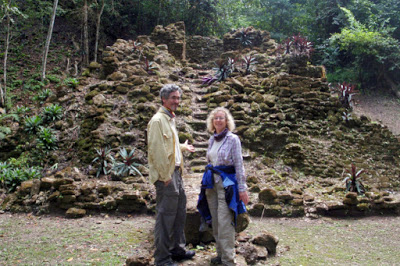
Evidence from the tropical lowlands of Central America reveals how Maya activity more than 2,000 years ago not only contributed to the decline of their environment but continues to influence today’s environmental conditions, according to researchers at The University of Texas at Austin.
Synthesizing old and new data, researchers were the first to show the full extent of the “Mayacene” as a microcosm of the early anthropocene — a period when human activity began greatly affecting environmental conditions.
“Most popular sources talk about the anthropocene and human impacts on climate since the industrial revolution, but we are looking at a deeper history,” said lead author Tim Beach, the C.B. Smith Sr. Centennial Professor of Geography and the Environment. “Though it has no doubt accelerated in the last century, humans’ impact on the environment has been going on a lot longer.”
By looking at Maya impacts on climate, vegetation, hydrology and lithosphere from 3,000 to 1,000 years ago, researchers propose that the Maya’s advanced urban and rural infrastructure altered ecosystems within globally important tropical forests.
The researchers identified six stratigraphic markers — or “golden spikes” — that indicate a time of large-scale change, including: “Maya clay” rocks; unique soil sequences; carbon isotope ratios; widespread chemical enrichment; building remains and landscape modifications; and signs of Maya-induced climate change.
“These spikes give us insight into how and why Mayas interacted with their environment, as well as the scope of their activity,” said Sheryl Luzzadder-Beach, co-author and chair of the Department of Geography and the Environment.
Maya clay and soil sequences indicated erosion, human land-use changes and periods of instability. Soil profiles near wetlands revealed heightened carbon isotope ratios due to agriculture and corn production; and researchers noted a three- to fourfold increase in phosphorus throughout Maya-age sediments.
However, the most visual indication of human impact was found in building material remains and landscape modifications. Researchers believe that these clues reveal how the Maya used water management to adapt to climate change.
“In studying the wetland systems, we were surprised to find a combination of human and natural contributions,” Luzzadder-Beach said. “Geochemical changes indicated that some wetlands were natural, while others were built landscapes used to grow crops away from the large population.”
The changes are both good and bad, researchers said.
“Historically, it’s common for people to talk about the bad that happened with past environmental changes, such as erosion and climate change from deforestation,” Beach said. “But we can learn a lot from how Maya altered their environment to create vast field systems to grow more crops and respond to rising sea levels.”
While some studies suggest that deforestation and other land use contributed to warming and drying of the regional climate by the Classic Period (1700-1100 years ago), many existing forests are still influenced by Maya activities, with many structures, terraces and wetlands still existing today, researchers said.
“This work speaks to the deep history and complexity of human interactions with nature, and in a part of the world where we still have little knowledge about the natural environment,” Beach said.
Reference:
Tim Beach, Sheryl Luzzadder-Beach, Duncan Cook, Nicholas Dunning, Douglas J. Kennett, Samantha Krause, Richard Terry, Debora Trein, Fred Valdez. Ancient Maya impacts on the Earth’s surface: An Early Anthropocene analog? Quaternary Science Reviews, 2015; 124: 1 DOI: 10.1016/j.quascirev.2015.05.028
Note: The above post is reprinted from materials provided by University of Texas at Austin.










